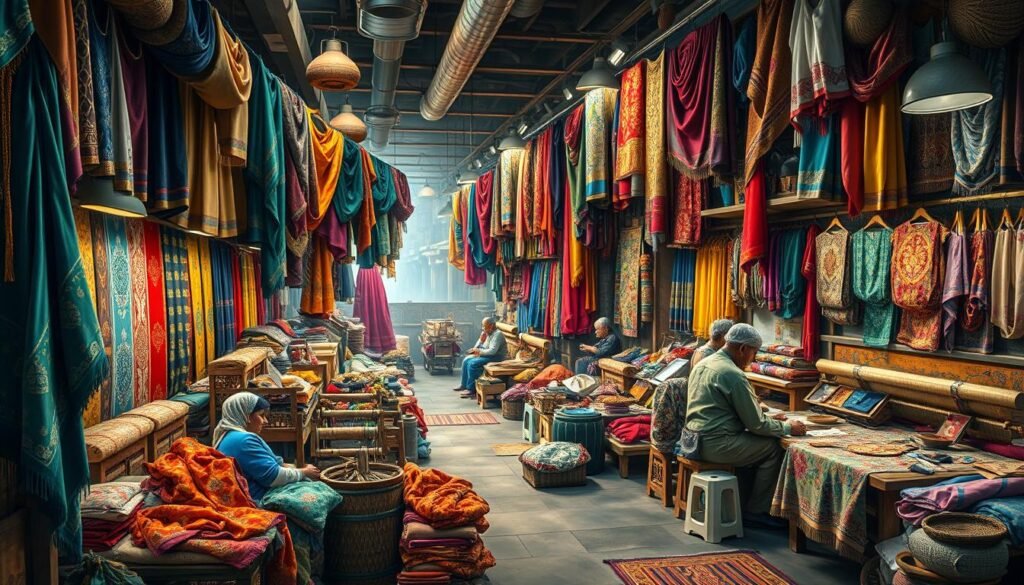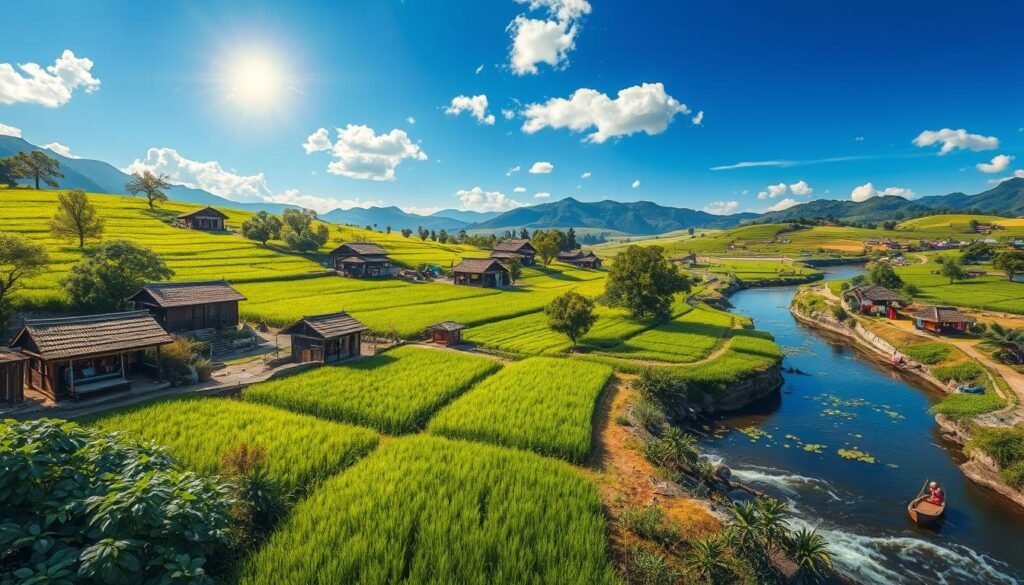“The future belongs to those who believe in the beauty of their dreams.” – Eleanor Roosevelt. This quote fits perfectly with the silk industry’s dreams. Dreams of luxurious textiles and new uses for silk paint a bright future.
The silk industry has a rich history going back thousands of years. It is still a key part of the world’s textile market. We will look at the main silk producers and leaders. They keep this beautiful material growing.
The silk market is worth about USD 16.94 billion now. It is expected to grow to $34.1 billion by 2031. This growth is at a rate of 8.2% each year. Key companies like Anhui Silk Co. Ltd., Kraig Biocraft Laboratories, Inc., and Wujiang First Textile Co., Ltd. play a big part. These companies are mostly in China and India.
China and India lead in making raw silk. They help the global textile industry a lot. They are also at the forefront of new ideas and making silk more sustainable.
Silk has many uses, from clothes to makeup. The industry keeps changing to stay current with market trends. This article will talk about the big silk producers. It will also cover their market share and how the silk industry is changing.
Key Takeaways
- The global silk market is projected to reach $34.1 billion by 2031.
- Asia-Pacific, particularly China and India, dominates raw silk production.
- Mulberry silk is anticipated to show the fastest growth in the market.
- The textile industry is the largest application area for silk.
- Key players like Anhui Silk Co. Ltd. and Kraig Biocraft Laboratories are shaping market dynamics.
- Sustainability efforts are influencing the future of the silk industry.
Introduction to the Silk Industry
Silk production’s journey began over 6,000 years ago in ancient cultures. It started in Neolithic China, within the Yangshao culture. The process, called sericulture, involves caring for silkworms to get silk threads. For a long time, China was the only silk producer, even when the Silk Road opened in 114 BC.
Silk is very desirable, making it valued in many areas of the textile industry. It’s known for being strong, soft, and shiny. People all over love it for clothes, furniture, and accessories. They enjoy its luxury feel.
Sericulture spread beyond China over time. By 300 AD, Japan and the Byzantine Empire had joined silk production. Italy and France became big players in the silk market after the Crusades. India, with a 4,000-year history of silk making, contributes significantly, especially in Karnataka.
Even though materials like nylon and polyester became popular, silk remained important. It holds great cultural and economic value globally. Silk’s history and its role keep it vital in the textile industry today.
Overview of the Global Silk Market
The global silk market is growing quickly. It’s expected to hit USD 20.0 billion in 2024. By 2034, it may reach USD 44.6 billion. This predicts a yearly growth rate of 8.4% from 2024 to 2034. Between 2019 and 2023, the market grew at 9.6% yearly. Key growth reasons are higher incomes, a love for luxury textiles, and a move towards green fashion.
Asia-Pacific leads in silk making, with China and India at the forefront. The top silk producers by 2034 are expected to be Korea, Japan, the U.S., China, and the U.K. The U.S. market could grow by 8.5% yearly, thanks to interest in quality silk. In the U.K., growth might hit 9.2% yearly due to demand for eco-friendly textiles.
China is predicted to see a 9.0% yearly growth, keeping its edge in quality and culture. Japan aims for 9.4% yearly growth, backed by skilled craftsmanship and tradition. Korea is forecasted to lead with a 9.5% yearly growth, thanks to new production methods and cultural tourism. This market segmentation helps firms grasp the market size. It also shows key trends in silk use in textiles, cosmetics, and biomedicine.
| Country | Projected CAGR (%) 2024-2034 |
|---|---|
| Korea | 9.5% |
| Japan | 9.4% |
| United Kingdom | 9.2% |
| China | 9.0% |
| United States | 8.5% |
This silk industry summary highlights essential trends. It shows what companies must consider adapting to new buyer tastes and market shifts.
Key Players in the Silk Industry
The silk industry includes many different companies, from big names to new startups. It’s key to know about these silk businesses to understand the market. The scene is made up of big producers and smaller ones that focus on being eco-friendly and offering special products. Key companies are a big deal in silk making. They also work together and use new tech to stay ahead.
Top Silk Producers Globally
China leads as the top silk maker worldwide, with India right behind. Uzbekistan and Thailand also play big roles. Each place has its strengths, like cutting-edge tech and different silk kinds, including Mulberry and Tussar.
- China
- India
- Uzbekistan
- Thailand
Big silk businesses like Anhui Silk Co. Ltd. and Wujiang First Textile Co. stand out. They keep a big part of the market by making top-quality silk items.
Market Share of Key Companies
Looking at how much of the market big silk makers own shows important trends. By 2023, the global silk market is worth US$ 18.7 billion. It’s expected to grow to US$ 34.1 billion by 2032, growing 6.9% a year. Companies like Kraig Biocraft Laboratories and Eastern Silk Industries are key to this growth.
| Company | Market Share (%) | Annual Revenue (USD Billion) |
|---|---|---|
| Anhui Silk Co. Ltd. | 19.5 | 3.65 |
| Wujiang First Textile Co. | 15.8 | 2.96 |
| Kraig Biocraft Laboratories | 12.1 | 2.27 |
| Eastern Silk Industries | 10.4 | 1.94 |
| ERIS GLOBAL | 8.3 | 1.57 |
These companies are very important in the silk market. They keep up with new trends and the growing want for eco-friendly products. They also innovate, making special items like silk pajamas and pillowcases from brands like Tianruiyi.

Major Types of Silk
The silk industry has many silk types, each with its own special qualities. Mulberry silk is the most common and loved for being luxurious. Tussar silk is rarer and known for its unique texture and color. We will look at these important silks, their traits, where they’re made, and how they’re used.
Mulberry Silk
Mulberry silk makes up about 90% of the world’s silk. It comes from Bombyx mori silkworms. This silk is super smooth and shiny. China is the biggest maker of mulberry silk. It’s used a lot in fancy clothes, luxury bedding, and decor. This silk is very important in the textile world.
Tussar Silk
Tussar silk comes from wild silkworms. It’s known for being rich and textured. This silk is found in China, India, Japan, and Sri Lanka. Its natural golden color and strength are great for traditional clothes like sarees. Tussar silk is getting more popular because it’s sustainable and handmade. It has a special spot in the global market.
Applications of Silk in Various Industries
Silk is used in many products and industries. It’s especially famous in the textile industry. Here, silk’s unique traits make it a top choice for many consumer goods. Items like clothes and home décor use silk a lot.
Textile Industry
Silk is crucial in textiles because it’s strong and feels great. People love silk for:
- Shirts and blouses
- Ties and suits
- Lingerie and pajamas
- Comforters and sleeping bags made from hand-spun mulberry silk
We have different silk fabrics like dupions and satin. They make fashion items more appealing. Silk is also in knitted items, like socks and stockings. This shows it’s a luxury product. For tips on silk making, check how to choose the best manufacturer.
Cosmetics and Medical Applications
In beauty, silk proteins help skin stay moist and smooth. So, silk is in many cosmetic products. Its medical use is also growing. Silk fibroin, for example, is used in stitches and making new tissues.
These uses show silk is great in medicine and beauty. It makes products better and helps in healthcare. This fiber mixes old and new uses in many fields.
| Industry | Silk Applications | Key Benefits |
|---|---|---|
| Textile | Clothing, bedding, home textiles | Luxurious feel, strength, durability |
| Cosmetics | Skin creams, serums | Hydration, improved texture |
| Medical | Surgical sutures, tissue engineering | Biocompatibility, healing properties |
Regional Analysis of Silk Production
The silk industry varies a lot around the world. The Asia-Pacific area is at the front of silk making. China and India, rich in silk history and tech, are leaders here. We gain insights into demand, trends, and cultural impacts on silk through these regions.
Asia-Pacific Dominance
The Asia-Pacific silk market adds greatly to the world. It was worth about USD 8 billion in 2022 and will grow more. With an 8.5% growth expected from 2023 to 2032. Mulberry silk brings in USD 10.7 billion alone.
India plays a big role, with 26,587 metric tons of silk by December 2021. This success comes from government backing and new methods that boost silk making.

Growth in North America and Europe
North America’s silk market is showing good signs. It’s growing because people want luxury and green textiles. In 2022, the U.S. made $65.8 billion from textiles and clothes.
Asian companies are trying new ways to enter this market. They’re teaming up with local brands. Europe is seeing similar trends. People there like silk for its luxury feel.
As these areas change, there’s both a challenge and chance for silk makers. Mixing sustainability with new silk products fits what people now want. They seek comfort and care for the environment.
Market Dynamics: Drivers and Restraints
The silk market’s growth is driven by several factors. The market size was valued at USD 20.91 billion in 2023. It is expected to reach USD 35.63 billion by 2031. This reflects a CAGR of 7.60% from 2024 to 2031. Key drivers include rising disposable incomes, evolving fashion trends, and a strong demand for sustainable textiles. Such factors boost interest in silk products, especially in North America, where ethical textiles are preferred.
Asia-Pacific stands as the top region for silk production. Countries like China and India have a rich history of sericulture. This gives them a strong position in the silk market. Cultural importance and skilled labor not only fuel economic growth but also support sustainability. Companies like Tianruiyi are dedicated to quality and innovation. They aim to set high industry standards.
However, the silk industry faces challenges. These include high production costs, labor shortages, and environmental concerns. Trade barriers and geopolitical tensions can also disrupt silk trade routes. This affects both market access and production costs. Overcoming these challenges is crucial for companies looking to grow in this evolving industry.
| Country | Metric Tonnes Produced |
|---|---|
| China | 50,000 |
| India | 36,582 |
| Uzbekistan | 2,037 |
| Vietnam | 1,067 |
| Thailand | 435 |
Future Trends and Opportunities in the Silk Industry
The silk industry is on the brink of big changes. Many factors will shape its future. Experts think the silk market will grow to USD 4309.4 million by 2030. This shows how important green silk making and new ideas are.
Technology is key for silk innovation. Companies use new tech to make silk better and greener. This is making the silk market grow in areas like medicine and green fabrics.
Asia-Pacific is leading in silk, with nearly all the market. China and India are focusing on green silk. This focus is creating lots of chances for investors and for the industry to grow.
The following table summarizes the projected market dynamics and opportunities within the silk industry:
| Year | Market Size (USD million) | CAGR (%) | Key Trends |
|---|---|---|---|
| 2023 | 3742.8 | 2.0 | Increased focus on sustainability |
| 2030 | 4309.4 | 2.0 | Growth in technological advancements |
| 2027 | 11497.07 | 2.5 | Emerging applications in biomedicine |
More people want green and custom silk products. This opens big chances for the silk market. The industry is moving towards eco-friendly making methods, meeting global sustainability goals.
Conclusion
The silk industry is growing and changing. It combines old importance with new changes. China is the top silk producer in the world. This country has been a big part of silk’s history since 2700 BCE. The Han Dynasty saw silk making really start to grow. Today, technology and online stores like Alibaba are making a big difference. They make silk making easier and help sellers reach buyers all over the world.
Consumer tastes are changing, and the silk market is keeping up. People who make silk are focusing on being green and making better products. This makes customers happy. Alibaba’s Green Alliance is helping make silk making good for the planet. This means the silk business can be both money-making and earth-friendly.
Looking ahead, the outlook for silk is very good. It stands strong and can adjust to new challenges. Countries like India, Brazil, and Italy are bringing their unique silk to the world. This mixture of old roots, fresh uses, and new ideas means silk is set to do well in the future.
FAQ
What is the silk industry and its significance?
The silk industry is about making and trading silk, a fancy fabric. It’s strong, shiny, and versatile. Silk has been important for over 6,000 years, especially in sericulture, which is raising silkworms. It is key in the world’s textile market, adding economic and cultural value.
Which countries are the leading producers of silk?
China and India are at the top of silk production worldwide. Other important producers are Uzbekistan and Thailand. They all play a big part in the silk market.
What are the major types of silk and their characteristics?
Silk comes in types like mulberry silk, which is smooth and high-quality. Tussar silk is rich in texture and seen as artisanal. There’s also eri silk. Each kind has its own uses and demand, based on its features.
How is silk used in various industries?
Silk is big in the textile world for things like clothes, fancy bedding, and decor. It’s also in cosmetics for its moisture and in medical uses like stitches because it’s safe for bodies.
What factors are driving the growth of the global silk market?
The silk market is growing because more people can buy things, there’s more call for luxury goods that are kind to the earth, and silk’s use is spreading to many areas, including medicine and green textiles.
What are the challenges facing the silk industry?
The silk industry faces tough spots like high costs, environmental worries, and relying too much on big suppliers like China. People in the industry are working hard to grow in a good way that lasts.
What future trends can we expect in the silk industry?
We’re looking at a move to make silk in ways that are good for the planet, care about ethics, and bring in new technology. There’s a growing interest in silk for medicine and eco-friendly cloth, which opens up chances for growth.




